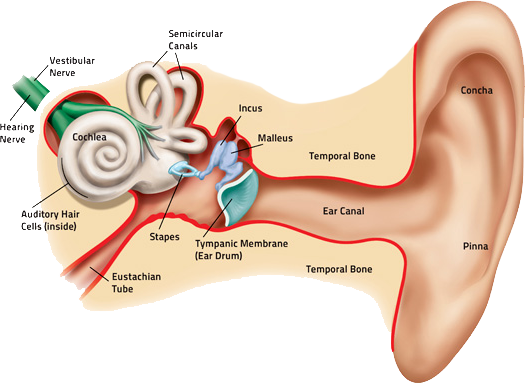How Do We Hear?
Sounds and noises are created by the vibrating of objects. When an object vibrates (such as a drum or the inside of a speaker) it rapidly moves back and forth, “pushing” and “pulling” away from the air in contact with the surface, creating alternate regions of high and low air pressure. These alternating regions create sound waves, which our ears capture and process.
Sound waves enter through the ear canal and are transformed into mechanical vibration at the ear drum. The complex system of the human hearing system eventually transfers sound information to the auditory nerve, which travels to parts of the brain to be translated into what we perceive as sound and noise.
What is the Difference Between Sound and Noise?
Noise is a difficult term to define; what is noise to somebody may be music to another. Some people define noise as a complex sound with irregular vibrations and no definite pitch, while others hear noise as a beautiful texture .
Traditionally, noise is defined as interference that distracts from or degrades the quality of a sound. In other words, noise can be viewed as a pollutant – a sound wave that can disturb and cause damage to its environment.
The definition of noise and sound depends on the individual asked, but whatever your definitions of noise and sound are, it is important to know that too much exposure to either at a loud volume can be hazardous to a person’s hearing. In other words, “pretty” sounds can cause just as much damage as “ugly” sounds to an ear if they are heard at an equal volume.
What Determines Pitch and Loudness?
Pitch is essentially the degree of how “high” or “low” a sound is. Pitch is determined by the frequency of vibrations. More vibrations per unit of time increase pitch while less vibrations per unit of time decrease the pitch. Pitch does not affect an individuals’ ability to hear as much as loudness does.
What we perceive as loudness is actually sound pressure. Sound pressure is the amount of fluctuation in air pressure caused by a noise source. Higher sound pressure strikes harder on the ear drum, making the sound louder. Sound pressure depends on the environment of the listener and the distance from the source; sound pressure would be higher in a small, echoing room like a bathroom than in a wide open soccer field.
How to Tell if You are Being Exposed to Dangerous Noise Levels…
Workers are commonly exposed to noises, especially in heavy industrial, manufacturing, farm, and cafeteria environments. These noises can not only be annoying, but can also be extremely damaging to the body and hearing system. Overexposure to noise can lead to irritation, stress, noise-induced hearing loss, and an increase in blood pressure.
You can tell if your workplace or environment is too loud to be considered “safe” if you have to raise your voice to be heard or if your ears ring (even slightly) upon leaving the workplace or environment. If you experience either of these things, consider getting earplugs or earmuffs to reduce exposure.
Daniel Shaw is a senior health advisor at a senior housing community. Many times, Daniel helps advise many of the senior residents that live within the community on matters of senior health and daily living. He believes that it is important to maintain a good healthy body with excercise, nutrition and mental well-being, even well into your senior years. This will help improve and maintain good health, social connections and mental clarity for day-to-day.


